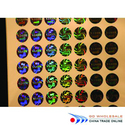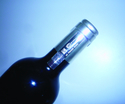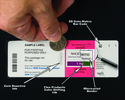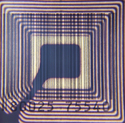There are many ways to outfox the counterfeiter
16 November 2011Jackie Marolda, vice president and senior consultant, AWA Alexander Watson Associates, outlines some market drivers and opportunities
The focus and technical capabilities of counterfeiters around the world continue to expand. Fake goods are now the biggest global brand, said to be worth around $650 billion (an estimated 5-7% of world trade), and growing exponentially. The biggest geographical source is said to be China, where fake goods are claimed to represent 8% of GDP.
Both consumer safety and the protection of the intellectual property rights of brand owners are the prime concerns of product manufacturers facing counterfeiting. The growth of sales of fake goods has been greatly enhanced in recent years by the opportunities presented by internet online sales websites, which enable counterfeiters to evade traditional channels of discovery and intervention.
There have been huge investments in border controls and policing – but their successes come to light after the event, and represent only the tip of the iceberg. ACTA – the international Anti-Counterfeiting Trade Agreement – is specifying an infrastructure (including the digital environment) that will enable cross-border controls to be maintained more easily, more transparently, and faster. ACTA is being ratified, and this year eight countries formally signed up to it, including the USA, but not yet the EU, which will enforce it “as soon as practicable”.
There is, however, a growing understanding that the brand owners themselves must be the starting point for a platform of product authentication and for securing their supply chain. This is a field where converters are contributing in a variety of ways, particularly in solutions involving product packaging, since this is the prime area to which authentication and tamper-evident devices are added.
There are many levels at which authentication, tamper-evident, and track-and-trace elements can be added to product packaging. The three major solutions employed today are devices for visual authentication (with the naked eye, or with a scanner); secure track-and-trace systems (creating a continuum through the supply and distribution chain); and the addition of features on or within packaging that are difficult, or impossible, to replicate.
Security devices may be overt or covert, to provide the broadest possible protection for everything from ethical pharmaceuticals and medical devices to legal documents, designer handbags, automotive and aerospace parts, foods, wines and spirits, toys, music CDs, consumer electronic goods, and computer software.
Perhaps one of the most familiar devices for identifying an authentic product is the barcode. The simple one-dimensional barcode is partnered today by two-dimensional barcodes and, based on the 2D technology, even three-dimensional barcodes – together representing the most ubiquitous track-and-trace technology.
Mass serialisation, which can trace right down to an individual barcode on an individual pack, makes barcodes unique single-item identifiers. They may be applied via a simple label, sometimes preprinted with a logo or other message, and often in partnership with other variable information print. The image may be created by direct thermal, thermal transfer, inkjet and laser printing. Barcodes may also be applied via digital print units on modular narrow web presses, or via the standalone reel-to-reel digital label presses.
From what was originally a ‘professionals only’ operation, barcode reading has also become an option for the world’s camera phone owners, for whom another ‘app’ is available: the ability to use their phone to read a 2D barcode via a QR (Quick Response) code on product packaging, and connect via Wifi to retrieve product information and traceability. This technology is now finding favour as an alternative to ‘specialist’ scanners across the entire authentication market.
International standards for the many available barcode system platforms are now resident within the global GS1 supply chain management standards association. They include EAN/UPC, ITF-14, and GS1 DataBar and DataMatrix, and EPCglobal standards for RFID implementation.
There are many other initiatives that mandate track-and-trace and product authentication technology as key elements in the protection of consumers and of genuine brand owners. New ISO standards for anti-counterfeiting tools and their performance criteria, are in preparation.
While standard barcodes require line-of-sight ‘reading’, RFID (radio frequency identification) does not. RFID tags, or ‘smart labels’ – generally applied to packages via a self-adhesive label, may be passive (generally read-only), or active be passive (generally read-only), or active (where tag data can be modified or rewritten, and can be transmitted over a greater distance). They can be read using either a handheld device or via a computer portal. Tags may be visible or concealed, according to the needs of the product and brand. System options and tag capabilities are proliferating, although converters need sophisticated equipment to insert a tag into a self-adhesive label laminate.
Overt, entry-level security devices often used on packages are familiar to consumers, and are a popular choice as a means of reassurance of brand authenticity and purity. Examples are over-the-cap, easily-frangible self-adhesive paper ‘seals’ on jars and bottles, or perforated stretch or shrink sleeve cap seals, which provide ready visual evidence of tampering. Other first-level devices include ‘hidden word’ self-adhesive label constructions. Applied as clearly visible pack seals (eg, to a CD‘ jewel case’), they provide strong visual proof of tampering if the seal is broken, since they leave behind a visible warning message. The word ‘void’ is standard in the industry, but personalisation is possible.
Inks – both standard and ‘sympathetic’ – and varnishes can be used to create patterns or other identifiers during the process of printing the pack or label.
Optically variable devices (OVDs), in the form of holograms, vary today in their level of sophistication. At their simplest, they are merely generic – created by a patterned print substrate – but they may also feature advanced and patented features for unique, instant verification of authenticity that are difficult to simulate, such as customer-unique micro incisions or kinetic effects such as colour changing. Many features can be engineered into a label substrate, such as two or three-dimensional customer-exclusive ‘watermarks’; UV or IR-light-detectable nylon fibres of a specific length or colour; metal strips or fragments,polyester security threads, thermochromic threads, and micro-marked fibres, invisible to the naked eye. In the wider world of packaging, solvent-sensitive papers, which prevent information from being removed with the use of solvent, are also available.
Iridescent security colour stripes, impossible to reproduce by photocopier, offset print, or computer printers, can be added to papers. Near-IR fluorophores, chemical taggants, and microtaggants, including plant DNA, can also be added to a container or label, detectable only with dedicated scanners; and there are tagging systems which are even invisible to forensic trace methods.
One market where there is a major drive towards increased, layered brand security is pharmaceuticals. The European Federation of Pharmaceutical Industries and Associations reports that more than 11 million illegal medicines were stopped at EU borders in 2009 alone; and, according to the UN, an estimated 30% of anti-infective treatments in Africa and South East Asia are fakes – including half the anti-malarial drugs sold in Africa. Unofficial World Health Organisation estimates indicate that counterfeit drugs could be responsible for the death of over 100,000 people every year.
Pharmaceutical packaging, therefore, has a major – but challenging – role to play in protecting the world’s populations from counterfeits, both by providing physical solutions and meeting the legislative requirements now being implemented.
In Europe this year, the EU Falsified Medicines Directive, Directive 2001/83/EC – which will be mandatory – was approved. It applies to all drug (including generics) manufacturers, contract packers, re-packers, and importers, and calls for the outer packaging of all prescription medications produced within the European Community to carry a unique non-predictive alpha-numeric number supported by tamper-evident labelling. Although the final details have yet to be ratified, it is probable that the unique number will be represented in human-readable and ECC200 2D data matrix format – a tried and tested system.
The Directive is expected to be implemented in most European countries in the next 18 months. Like the REACH hazardous chemicals legislation, it will have major impact around the globe on the whole pharmaceutical supply chain.
But this is not the only initiative in global pharmaceutical legislation. From July this year, the Indian Government has required barcoding on all exports of pharmaceutical products, making track-and-trace technology mandatory at all levels of packaging to ensure GS1 global standards are met; and the use of serialisation for pharmaceuticals is now the subject of legislation in Turkey and Brazil.
There is proof that such initiatives are truly effective. In the US, Merck Serono’s adoption of one of the pharmaceutical industry’s earliest data matrix coding strategies for its Serostim product eliminated counterfeit HIV treatment drugs in the supply chain in less than two years.
Authentication and track-and-trace solutions are often layered on packaging in customer-unique (and even product-unique) applications, especially for high value goods. Many of the available options can easily be incorporated by packaging and label production companies.
Some high visibility cases of counterfeit wines have led to a focus on authenticating such products. A maker of fake wines arrested in China recently had 50,000 empty bottles bearing labels from dozens of real brands, waiting to be filled with a fake chemical concoction. In the UK, counterfeit wine believed to be imported from China has been found for sale in numerous off-licences – labelled as ‘Jacob’s Creek’, and doing Australia’s largest wine brand no favours. Fake spirits – particularly vodka – are also a global problem. Around 50% of all vodka sold in Russia is counterfeit, with over 40% of all fatal poisonings attributable to counterfeit alcohol.
The label on a bottle can be an effective carrier of both overt and covert brand security devices. High value wines can be effectively destroyed if the bottle must be opened to authenticate its contents, so overt solutions have much to contribute in this arena. Security tags attached to the seal on the neck of a bottle can guarantee that it has not previously been opened; and a potential buyer can simply and instantly verify the bottle’s provenance via the internet or a mobile phone.
This is just one example of a leading-edge technology that has particular affinities with a highly specific product market, and the available platform continues to proliferate.
The fitness for purpose of such product security solutions, and the continuing drive to create new dimensions, makes them a valuable addition to any packaging or label converter’s business. Adding track-and-trace and authentication technology to a label or package is a real benefit for a brand owner, and can promote customer loyalty as well as delivering improved profitability.
This is an opportunity for converters of all packaging to offer added value, in a global marketplace where consumer safety is becoming ever more paramount, and – for once – in an arena where innovation is the driver, and not price.
Jackie Marolda Jackie Marolda Holographic security label Holographic Prooftag’s Bubble Tag seal protecting wine Prooftag Coin reactive inks encourage customer interaction Coin RFID does not require line-of-sight reading RFID Tamper-evident security label Label Hidden word seals provide proof of tampering Hidden








